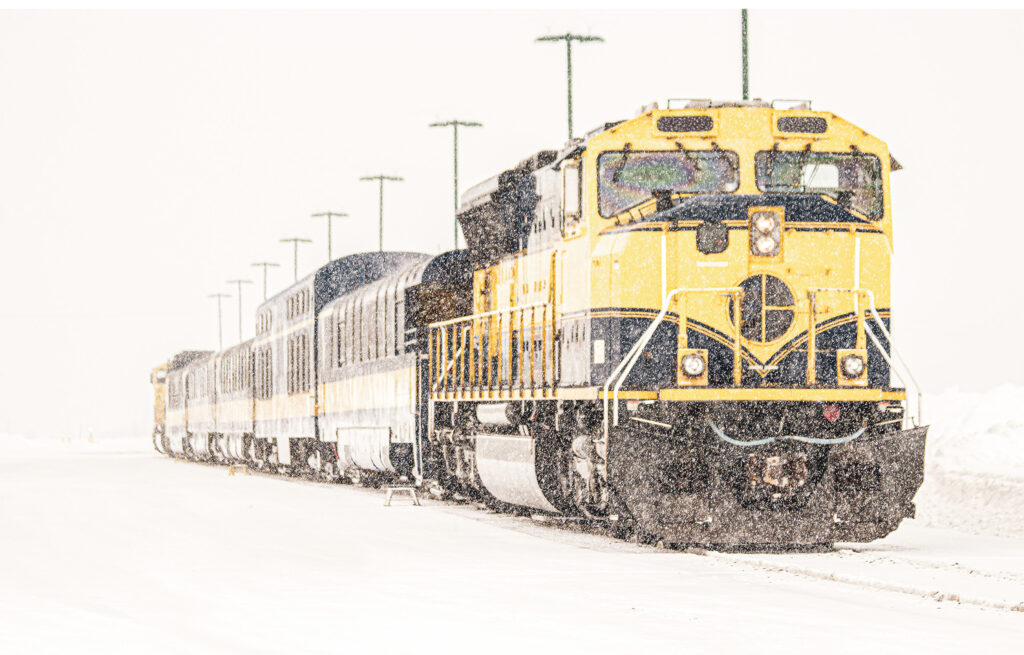An Alaska Railroad locomotive pauses on the tracks after passengers board before leaving the station in Anchorage in an undated photo. (Photo by Brenda F. Grimes/Getty Images)
I recently spoke with a European friend who told me she wants to visit Alaska, travel, and hike around the state. She was surprised when I told her that public transit, specifically the rail system, is severely limited and much more expensive than air travel. Alaskans and visitors deserve efficient and affordable ways to move around the state. As we approach this fall’s elections, it’s important to think about the leadership we want and which candidates will work to enhance our economy and quality of life. Establishing a commuter rail system is a crucial part of that vision. Here’s why.
This fall, a round trip from Anchorage to Fairbanks on the Alaska Railroad’s Aurora Winter Train will cost you $452, which is $250 more than a ticket on Alaska Airlines. And if you’re visiting the state and want to take a trip to Denali without a driver’s license, a round trip by train from Golden Heart City will set you back $176. While only about 200 passengers per day desired an idyllic ride through the wilderness in the first quarter of 2024, most of us just need a solid public transit that won’t break the bank.
Streamlining commutes and easing travel
Many, including the previous gubernatorial administration, have recognized the commuter rail system as a doable solution to overcrowded roads. Bill Walker in 2018 established the Commuter Rail Advisory Task Force, which was rescinded by Mike Dunleavy in 2019. The goal of Walker’s initiative was to look into establishing a commuter rail line between Wasilla and Anchorage. The Mat-Su Borough is the state’s fastest-growing area, with a population of approximately 113,000. Many residents from the valley commute to Anchorage for work daily. According to the state’s Department of Transportation & Public Facilities, the Glenn Highway between Anchorage and Mat-Su Valley witnesses 33,000 vehicles every day. With no viable alternative route, an increasing number of Alaskans in the Mat-Su Valley daily waste one and a half hours (without traffic) commuting to and from work.
A commuter rail system is a solution that will save Alaskans time and stress. According to an early report shared by Alaska Commuter Rail Coalition, a monthly train ticket would cost commuters 74% less than paying for gas and parking.
Pragmatic economic solution funded with federal dollars
Walker’s administration found that the pilot program for the Wasilla-Anchorage line would cost $15.2 million to cover annual operating expenses and initial capital. Considering inflation, that figure would now be approximately $20.2 million, or 0.16% of the state budget for the current fiscal year. The Alaska Railroad would operate the program on the existing tracks. The bulk of the infrastructure is ready to serve hardworking Alaskans and those who want to visit our state.
The good news is that the state won’t need to use its own funds to finance the public transit we deserve. Congress in 2021 passed the Bipartisan Infrastructure Law, which includes funding for passenger rail improvement. The Alaska Railroad has already received an $8.2 million grant to replace a bridge on the North Corridor mainline in Willow. Money for the project comes from the law’s Federal-State Partnership for Intercity Passenger Rail Program, which, despite its emphasis on passenger rail, mostly benefits Alaska’s freight service. Our congressional delegation supported the historic investment, recognizing the need for updated public infrastructure. Commuter rail will not cost the state an arm and a leg. The Alaska Railroad must take greater advantage of federal dollars and offer transit options we can all appreciate. In 2002, the state-owned corporation issued a 234-page report on commuter rail benefits. It’s time to turn this theory into action.
A smart and safe solution to traffic
On average, Americans spend 54 hours a year in rush hour traffic. To me, riding a train to work sounds like a much more pleasant experience than being stuck on the road. Commuter rail is one of the safest modes of transportation and promotes economic development by expanding tax revenue and improving access to urban centers.
An efficient commuter rail system would also increase the number of tourists. My friend from Europe, who doesn’t have a driver’s license, could finally visit me and experience the beauties of our state. International tourists currently represent only 5% of all visitors. If we want people from around the world to come and spend money, we have to invest in transit infrastructure.
We deserve infrastructure supporting the prosperous, diversified economy we aspire to build. This November, let’s elect leaders who prioritize our well-being and ensure we stop wasting time and money on our highways.
GET THE MORNING HEADLINES DELIVERED TO YOUR INBOX

